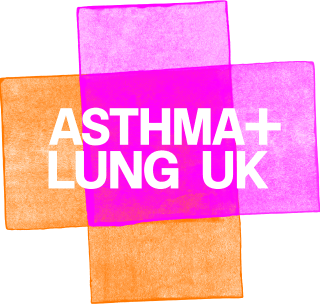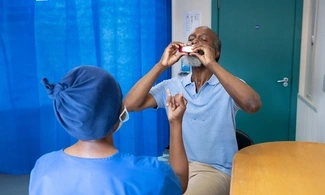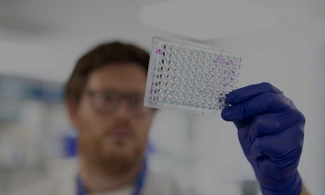Speak to your GP if you have symptoms
If you have any of the symptoms of pulmonary hypertension, speak to your GP.
Symptoms include:
- breathlessness
- feeling very tired
- chest pain
- palpitations
- feeling dizzy
- swelling in your ankles and legs.
Your GP may ask questions about your symptoms, family history, any medicines you take, and any other medical conditions you have.
They may refer you for some tests on your heart and lungs.
Getting a diagnosis of pulmonary hypertension can take a while because symptoms like breathlessness can be similar to many other lung conditions, like asthma or COPD. Andy Whittamore, Asthma + Lung UK’s GP.
Pulmonary hypertension tests
Most people will need to have a range of tests to get an accurate diagnosis of pulmonary hypertension. Tests can also help rule out the condition.
Tests can show:
- what type of pulmonary hypertension you have, based on what’s causing it
- how severe your pulmonary hypertension is. This helps doctors understand how much your pulmonary hypertension is affecting you, so they can find the right treatment for you.
- underlying conditions, such as lung or heart conditions.
Based on your test results, specialists can confirm the type of pulmonary hypertension you have, how severe it is, and how it needs to be treated.
You should have access to the support of experts based in specialist centres around the UK.
How severe is your pulmonary hypertension?
The World Health Organization (WHO) developed a system based on how much physical activity you can do before you start to notice symptoms.
Doctors can then use this as a guide to make sure you get the right treatment for your pulmonary hypertension.
The two main tests used to help diagnose pulmonary hypertension are an echocardiogram and right heart catheterisation. Doctors will use other tests too. Most people will need a number of different tests before getting a diagnosis.
Echocardiogram
An echocardiogram is a scan to look at your heart. It can show how well your heart is pumping blood. It can also help give doctors an idea of the pressure in the blood vessels to and from your heart.
This is often the first test to show if you may have pulmonary hypertension. But other tests will be needed to help confirm the diagnosis.
An echocardiogram can also show if you have a congenital heart problem. This is a heart condition you were born with. Congenital heart problems can cause pulmonary hypertension.
Right heart catheterisation
A test called right heart catheterisation is the best test to confirm if you have pulmonary hypertension. This test is done at a specialist pulmonary hypertension centre.
During the test, your doctor inserts a small flexible tube called a catheter into a vein and through to the arteries.
The catheter can take measurements and gives doctors information about blood pressure in the right side of your heart and pulmonary arteries.
You can stay awake for this test, but doctors will numb the area using a local anaesthetic so it’s more comfortable.
Pulmonary Hypertension UK have a video explaining right heart catheterisation.
Other tests you may need
An electrocardiogram (ECG) records the electrical activity of your heart. It’s a quick and simple test that can quickly show any problems with your heart rate or heart rhythm.
Doctors may ask you to monitor your ECG for 24 hours at home. This is so they can check your heart as you do your normal daily activities.
If you’re diagnosed with pulmonary hypertension, you may also have this test when you go for routine appointments, as part of your pulmonary hypertension check-up.
CPET is an exercise test. It’s where your heart rate, blood pressure and oxygen levels are measured while you exercise.
This will usually be on an exercise bike or walking on a treadmill.
The results of your CPET test can show how much exercise you can do, which helps doctors decide the best treatment for you.
Pulmonary Hypertension Association UK has a video showing what happens during a CPET test.
This is a simple test to test your blood pressure, oxygen levels and heart rate as you walk.
Walk tests can show how your pulmonary hypertension is affecting everyday activities, and can help doctors check you’re on the right treatment plan.
Pulmonary Hypertension Association UK has more information about the different types of walk tests and a video.
A chest X-ray can show if your heart is larger than normal. A larger than normal heart can be a sign of pulmonary hypertension.
A chest X-ray is not enough on its own to diagnose pulmonary hypertension though. You’ll need a range of tests to get an accurate diagnosis.
A chest X-ray can help confirm other possible reasons for your symptoms, like another lung condition causing breathlessness. It can also show scarring in your lungs.
A CT scan can show other lung conditions, and any problems in your heart. It can also show any blood clots in your lungs.
An MRI scan looks at the function of your heart. It can give a clear picture of your heart and lungs and the blood vessels around them.
It can also show blood clots in your lungs.
A ventilation-perfusion scan is a special scan used to look for blood clots. It measures the amount of oxygen and blood flow in your lungs.
You may be asked to complete questionnaires to see how pulmonary hypertension is affecting your everyday life.
Treatment for your pulmonary hypertension
Although pulmonary hypertension cannot be cured, there are treatments to help reduce your symptoms and help you manage the condition. Lifestyle changes and exercise are important too. Andy Whittamore, Asthma + Lung UK’s GP.
Treatment for pulmonary hypertension aims to improve your quality of life and help you live as well as possible.
Treatment for pulmonary hypertension aims to improve your quality of life and help you live as well as possible.
Most types of pulmonary hypertension respond well to a range of treatments. Your specialist can support you in finding the right treatment plan for you, based on what’s causing your pulmonary hypertension and how severe it is.
It’s important to treat pulmonary hypertension to stop it getting worse.
Your treatment plan should include:
- medicines suitable for your type of pulmonary hypertension.
- lifestyle advice, including how to look after your mental health
- a physical activity programme that’s suitable for you
If your pulmonary hypertension is caused by another condition, this needs to be treated too. Treating any underlying conditions can also help control your pulmonary hypertension.
Medicines to treat pulmonary hypertension
Medicines for pulmonary hypertension work by improving the blood flow through the arteries.
Treatments called pulmonary vasodilators can lower the blood pressure in your pulmonary arteries by relaxing and opening up the arteries.
This means the blood can pass through more easily and your heart does not have to work as hard.
Pulmonary vasodilators include medicines called:
- calcium channel blockers which are a group of medicines that open the blood vessels
- phosphodiesterase 5 (PDE5) inhibitors which relax the blood vessels
- endothelin receptor antagonists which reduce the effect of a substance called endothelin. Endothelin can cause the blood vessels to get more narrow
- soluble guanylate cyclase stimulators (SGCSs) which open up the blood vessels and are also used for pulmonary hypertension with blood clots
- prostanoids are a group of medicines that open up the blood vessels.
Background or supportive therapy
You may also have treatments to help with your symptoms. This is called background (or supportive) therapy.
This may include:
- diuretics or water tablets to remove excess fluid from your body. Find out more about diuretics for pulmonary hypertension
- oxygen therapy to increase the level of oxygen in your blood and may make you feel less breathless. Find out more about oxygen therapy for pulmonary hypertension
- blood thinners (anticoagulants), such as warfarin to prevent blood clots. Pulmonary hypertension increases the risk of blood clots in the blood vessels
- flu and covid vaccinations
- iron tablets
- mental health support
- physical activity and lifestyle advice.
Surgery when you have pulmonary hypertension
Some people with pulmonary hypertension may need surgery.
Pulmonary endarterectomy (PEA)
A pulmonary endarterectomy (PEA) is an operation to remove old blood clots from your pulmonary arteries. This improves blood flow and reduces the pressure inside your arteries.
Balloon pulmonary angioplasty (BPA)
BPA is a treatment for people with chronic thromboembolic pulmonary hypertension (CTEPH).
During a BPA, a tiny balloon is guided into a narrowed lung artery and inflated to the size of a pea for a few seconds to clear any blockage and widen your artery. BPA can improve blood flow through your lungs and reduce pressure on your heart. This can make it easier for you to be active.
You can find out more about BPA from the Royal Papworth Hospital which provides it.
Atrial septostomy
This is a surgical procedure where a small hole is made in the wall between the left and right side of your heart.
It reduces pressure in the right side of your heart so it can pump more freely.
Transplant surgery
Most people will not need a transplant, because there are so many different drugs available to treat pulmonary hypertension.
But if your pulmonary hypertension is severe or does not respond to treatment, a lung transplant or a heart-lung transplant may be considered.
If you have another lung condition
It’s important to manage your other lung condition as well as possible with support from your GP and other specialists.
If you’re also living with another lung condition like COPD, idiopathic pulmonary fibrosis (IPF), emphysema or sarcoidosis, you should be given expert advice about the treatments suitable for you.
Treatments like pulmonary vasodilators suitable for pulmonary arterial hypertension (PAH) may not be suitable for you if you have an underlying lung condition.
Physical activity and pulmonary hypertension
Pulmonary hypertension makes it harder to exercise and be active. However, being active can help you manage your condition.
Your specialist team can help you build up your activity levels safely over time. There are also programmes like pulmonary rehabilitation, which can support you to exercise gradually and safely and to learn breathing techniques. Evidence shows that this programme can help improve people’s wellbeing.
Try our Keep Active programme.
More support
The Pulmonary Hypertension Association (UK) provides support and detailed information for people affected by pulmonary hypertension, including individual treatments.

Get support
Our helpline is closed from 1pm on Wednesday 24th December 2025 and re-opens at 9:15am on Friday January 2nd 2026. Our supporter care line is also unavailable during this period. If you have a flare-up of your lung condition symptoms, contact your GP or healthcare professional or 111 for advice. Always dial 999 in an emergency.








